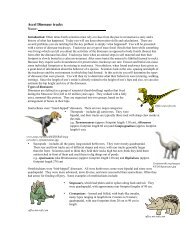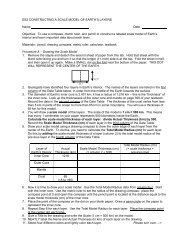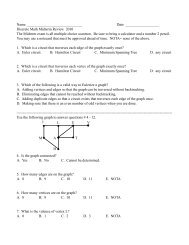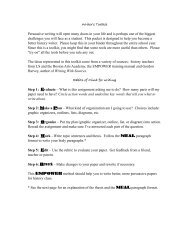Fetal Pig Dissection Introduction: Today, we begin a new chapter in ...
Fetal Pig Dissection Introduction: Today, we begin a new chapter in ...
Fetal Pig Dissection Introduction: Today, we begin a new chapter in ...
Create successful ePaper yourself
Turn your PDF publications into a flip-book with our unique Google optimized e-Paper software.
ii. ____ Papillae: Bumps on the surface of the tongueiii. ____ Teeth: How many teeth can you count <strong>in</strong> your pig’s mouth?1. Do both jaws move up and down or just one? ________iv. ____ Pharynx: The throat (back of mouth)v. ____ Epiglottis: The small white tab found at the back of thepharynx. This is made of cartilage. The jaw must be open verywide to see this.vi. ____ Esophagus: Only the open<strong>in</strong>g, or glottis, of the esophagus isvisible at this stage. It lies beyond (dorsal to) the epiglottis. It isessentially, the open<strong>in</strong>g.vii. ____ Larynx: Not visible yet, but feel for the “Adam’s apple” fromthe outside of the pig’s throat. You will see this when the throatarea is dissected later.B. ____ Abdom<strong>in</strong>al cavity: Now you are ready to exam<strong>in</strong>e the viscera(<strong>in</strong>ternal organs) of the abdom<strong>in</strong>al cavity. Read through all of the stepsfirst, then go through them aga<strong>in</strong> perform<strong>in</strong>g each step.i. Place pig on its dorsal side (belly up)ii. Lift the th<strong>in</strong> wall of the abdomen above the umbilical cord, hold<strong>in</strong>git away from the <strong>in</strong>ternal organs. Insert the f<strong>in</strong>e po<strong>in</strong>t of yourscissors, or scalpel, through the wall of the abdomen where lifted.Cut through the sk<strong>in</strong> and muscle to the cavity. Always cut with anupward motion to avoid damag<strong>in</strong>g the <strong>in</strong>ternal organs.iii. Cut <strong>in</strong> a straight l<strong>in</strong>e own the midl<strong>in</strong>e of the pig from the umbilicalcord to the bottom of the sternum. DO NOT CUT THROUGHTHE RIBS or DIAPHRAGM.iv. Refer to the diagrams below for help on the follow<strong>in</strong>g directions:1. Cut around the umbilical cord. The umbilical ve<strong>in</strong> extendsfrom the <strong>in</strong>side of the umbilical cord to the liver, the largegrown organ <strong>in</strong> the abdomen. You will have to cut theumbilical ve<strong>in</strong>, but note it first.



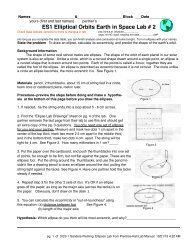


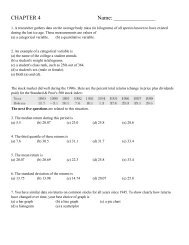


![';1asAu ro; las I sgeo8 leuo!]eslanuol aql utelqo o1 palenttouJ ue I ...](https://img.yumpu.com/49072782/1/190x221/1asau-ro-las-i-sgeo8-leuoeslanuol-aql-utelqo-o1-palenttouj-ue-i-.jpg?quality=85)



